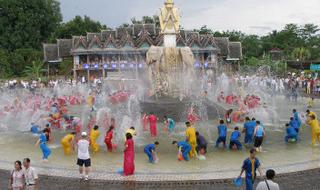Conference Day 4 – Field Trip into Domestic Chinese Tourism Land
One of the highlights of the conference that I help to organize here in China is the field trip. We generally do this in the middle of the conference, and it is often an all-day affair. This year, the original plan was to do two half-day trips to a Dai Village and to a border town. The border town, however, was closed to day trips by the Chinese government to stop Chinese nationals from going to Myanmar to gamble. So the new plan was to go to a tea plantation in the morning and to the Dai village in the afternoon. But when we woke up it was raining, making the road to the tea plantation unpassable. We would have been the first international tour group to visit this plantation. So, instead we went to the botanical gardens, which is a mass domestic tourist destination and has a very well done visitors interpretive center on the rainforest and local ethnic groups. It is one of the best that I have seen in China – where many interpretive centers only show oddly shaped rocks that look like birds and other objects, and discuss local folk mysteries as scientific facts.
Getting to the botanical gardens involved a bumpy two-hour bus ride in 15-passenger mini-vans with a police escort to move everyone off the road and out of our way. After the gardens we went to the Dai village, which included a walk through a village along with throngs of Chinese tourists and past house after house selling souvenirs and other items from their ground floor. (Dai houses are built on stilts with the living quarters well above the ground and covered by a massive roof.) It was an example of culture-commodification in the extreme! We were then brought to a massive arena-type stage where 100 “beautiful Dai girls” and a few Dai men danced for us and a hundred or more other tourists. Following the dance they held a beauty contest in which audience members could pay to select which of a smaller number of Dai “girls” was the most beautiful.
We did not stay to see the results, but made our way, instead, to the large water fountain. It was bout 50+ meters (150 feet) in diameter and had a large elephant fountain in the middle. This was where the daily water festival occurs. Originally a Dai New Year’s event, it is now performed daily with the “100 beautiful Dai girls” and about the same number of visitors who put on Dai costumes to keep their own clothes from getting wet. About a dozen of the Chinese members of our group joined in. We were placed in a special viewing area set aside for our group.
Each person had a large plastic bowl and at an appointed time, everyone started scooping water with their bowls and splashing each other. There were several rounds of this, mostly with the women on the inside and men on the outside in what I considered an unfair battle of the sexes. It looked like a lot of work!
After the water festival we wandered the Dai village for about an hour before having dinner at a Dai guesthouse and restaurant. There are a lot of home stays in this village, which was also the cleanest and tidiest traditional hill village that I have ever been in. There was not trash anywhere. The people here were clearly raking in the money from the tourists. At the same time, there seemed to have been maintaining many key aspects of their traditional lifestyle. I was later told that this has been the most successful and longest lasting ethnic village tourism enterprise in China (where many such efforts fold after a couple of years). These people seemed to really have their act together – and could probably teach a lot of other traditional people a few things about “mass tourism” development.
Photo: The Daily Dai Village Water Festival (below)


0 Comments:
Post a Comment
<< Home